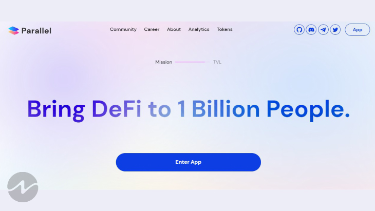Decentralized Finance (DeFi) has grown to be a crown jewel of the crypto ecosystem, with over $203 billion locked in various protocols as of writing. While there are many DeFi projects that currently exist, some have a more valuable proposition than others. In this article, we introduce Parallel Finance, a Polkadot-built DeFi protocol whose goal is to increase capital efficiency and liquidity for Polkadot users.
Launched in April 2021, Parallel Finance kicked off as a hackathon project led by Yobo Ruan, previously a student at Stanford. The protocol has since grown to become a leading DeFi protocol within the Polkadot and Kusama ecosystems. Some of the notable achievements include securing a slot in Kusama’s October auctions and another one in the 4th Polkadot auction held in December 2021.
Polkadot’s Money Market Protocol
At the core, Parallel Finance is built as a decentralized money market protocol to cater for the growing Polkadot community. This protocol introduces native features that solve the existing liquidity crunch in DeFi markets. Most notably, Parallel Finance offers leverage staking, algorithmic staking, auction loan, parashares, and insurance pool. Let’s take a deep dive into each of these features to get a better picture.
1.Leverage Staking
Leverage staking is a relatively new concept; ideally, this feature allows Polkadot and Kusama users to earn an extra yield from their staked tokens. With Parallel Finance, DOT and KSM token holders can lend their staked tokens on the platform’s liquidity pool. This increases the yield potential, given that users will earn a passive income from both staking on the network and the Parallel Finance liquidity pool.
Users can also increase their liquidity provider (LP) positions on Parallel Finance depending on their risk appetite and ability. However, it is noteworthy that leverage staking carries some amount of liquidation risk which means that LPs should be cautious when adding leverage. That said, this advanced feature is an efficient way of putting to use idle KSM or DOT tokens that are staked on either network.
2.Algorithmic Staking
In addition to leverage staking, Parallel Finance enables users to find the best DOT or KSM staking nodes through a reputation-based algorithm. This feature is particularly lucrative for newbies in the Polkadot ecosystem who are still learning the ropes on DeFi staking. Notably, the reputation algorithm overlooks the governance aspect, which in some cases may affect the total number of available nodes.
3.Auction Loan
The Auction Loan feature is designed to introduce liquidity for projects and individuals looking to participate in DOT/KSM parachain auctions. While still in the works, this feature will be fundamental in sourcing crowdloans within the Polkadot ecosystem. Essentially, the Auction Loan interface will facilitate a direct borrowing avenue for stakeholders whose tokens are locked in parachains. This means that DOT and KSM parachain auction participants can access some liquidity without compromising their slot positions.
4.Parashares
Parallel Finance also provides an opportunity for Polkadot and Kusama users to participate in crowdloans. KSM or DOT holders who leverage this feature will be given ‘shares’ that they can use to redeem their locked tokens. Additionally, these ‘shares’ can be lent or borrowed, enabling crowdloan participants to stay afloat while their tokens are locked. Not only does this feature solve the liquidity issue, but makes it simpler to be a crowdloan participant on Kusama or Polkadot.
5.Insurance Pool
Given the volatile nature of the crypto market, Parallel Finance introduces an insurance pool to hedge against price slippage instances that may result in liquidation events. The project has set aside 5% of its total native token supply (500 million PARA tokens) towards an insurance fund to refund users who are liquidated due to price changes within the given time-bound in which they had placed an order.
PARA/HKO Token
The Parallel Finance ecosystem is powered by a native token dubbed PARA (for the Polkadot ecosystem) and HKO (Kusama version). Its total supply is 10 billion, divided for various functions, including crowd loans (15%), liquidity mining (25%), team $ advisors (20%), seed investors (5%), private investors (15%), ecosystem fund (15%) and an insurance fund (5%).
As for the utility, PARA tokens enable multiple operations within the Parallel Finance DAO-governed ecosystem. Here are some of the major utilities;
Protocol Governance
Parallel Finance users who hold the PARA token will be able to participate in the platform’s governance by voting. Some of the issues on which users have a say include network upgrades, changes to incentives, referenda, governance action, parameter adjustments, and council elections.
Transaction Fees
The native PARA token will be used to pay for on-chain transactions, enabling users to stake, lend, borrow, participate in crowdloans and other peer-to-peer interactions such as swapping tokens.
Network Incentives
Like most incentivized DeFi projects, the Parallel Finance staking and liquidity mining program will reward users through PARA tokens. This native token will be minted on a continuous basis, rewarding collators who support the Parallel Finance network.
Security Module Staking
Besides node staking, Parallel Finance users can stake PARA tokens on a featured security module to hedge against the risk of slashed incentives. Stakeholders who contribute to the insurance pool will be compensated in the event staking rewards are slashed.
Validator Insurance
PARA tokens will also act as validator insurance for Kusama non-active validators. Basically, this native token increases the chance of one being picked by the Parallel Finance algorithm to become an active validator.
Looking Ahead
Though still a nascent ecosystem, Parallel Finance plans to scale its DeFi suite, featuring an Automated Market Maker (AMM) DEX and other cross-chain products. These features will enable the platform’s users to trade and access DeFi products that are hosted on multiple blockchain networks.
The team is also working to improve the current status of its decentralized money market protocol to enhance the user experience. Some of the features that will be upgraded include leverage staking and crowdloans. In doing so, Parallel Finance is optimistic about building the next frontier of decentralized money markets.

